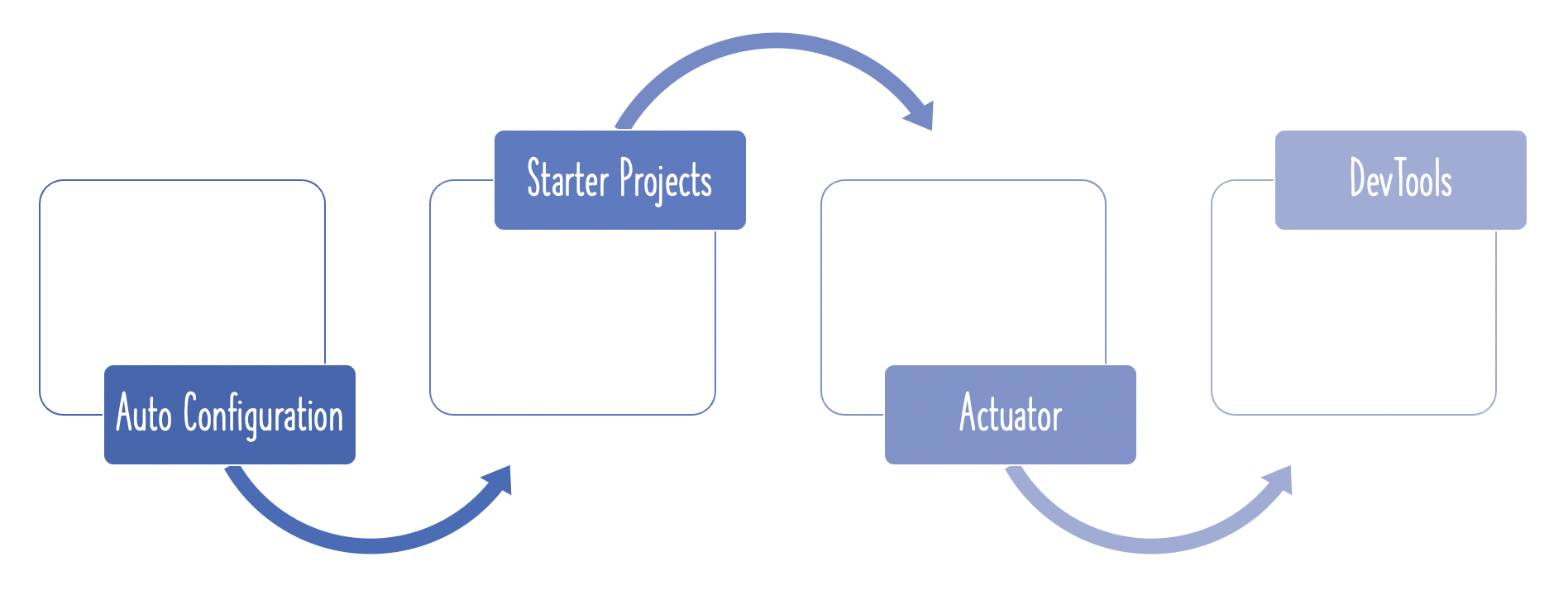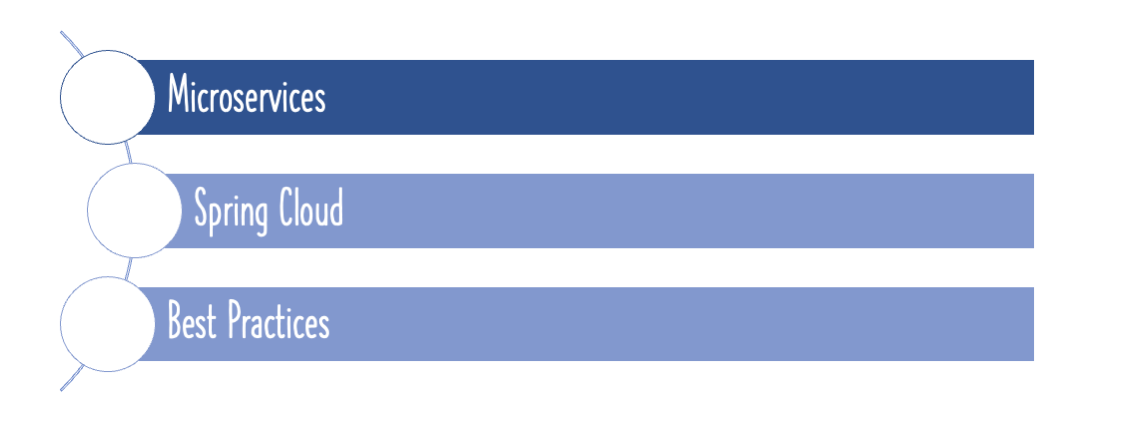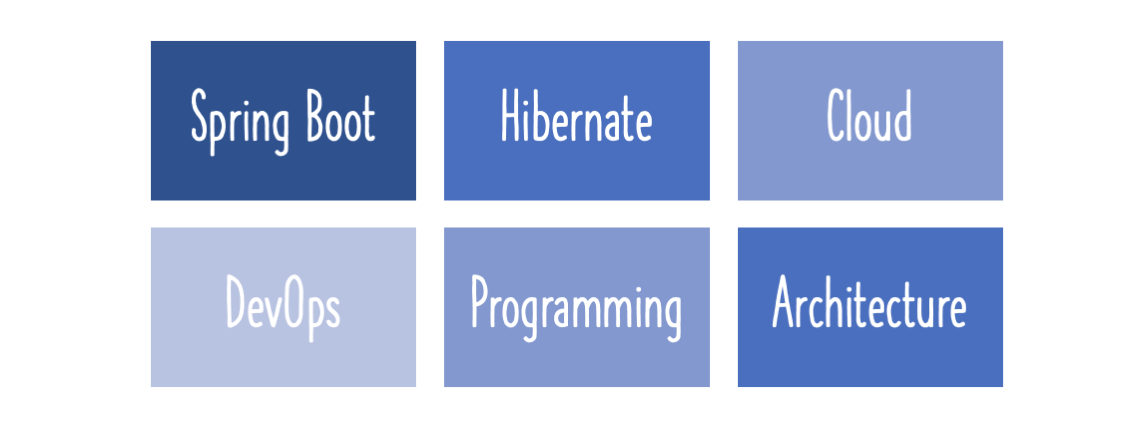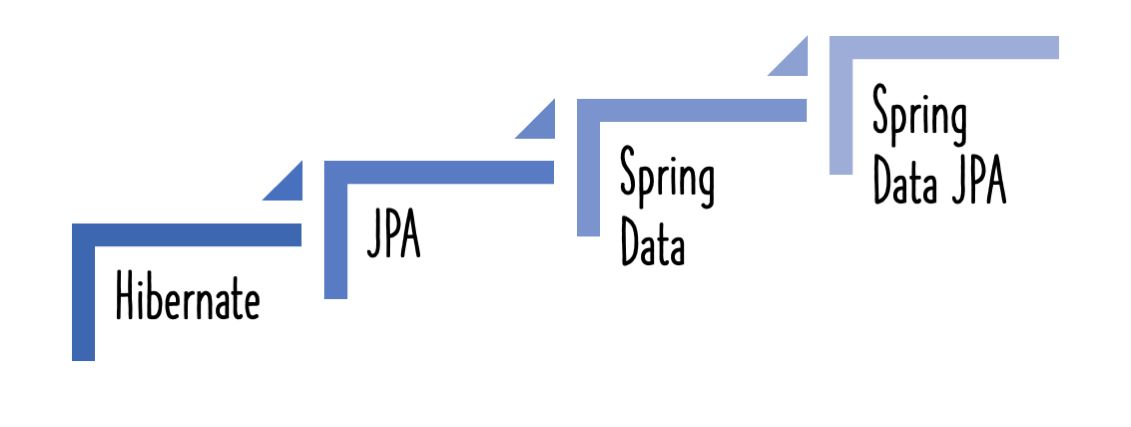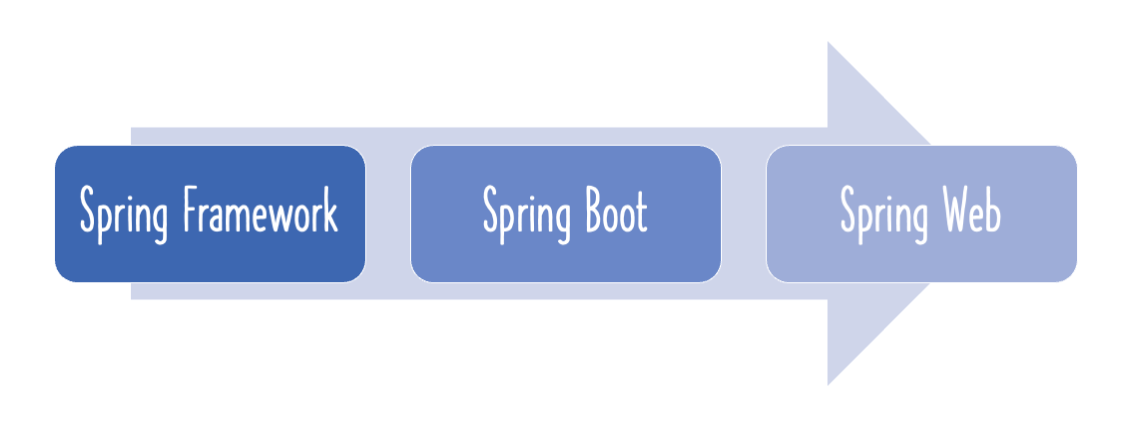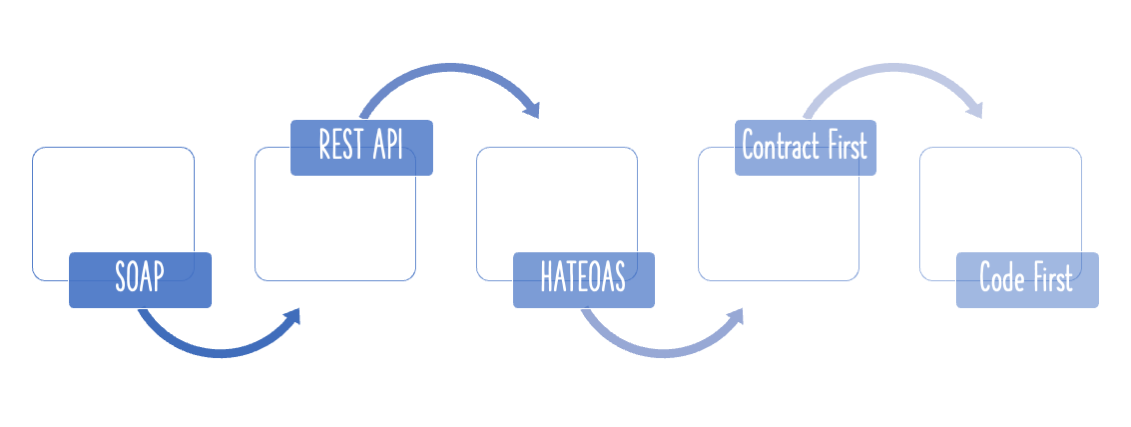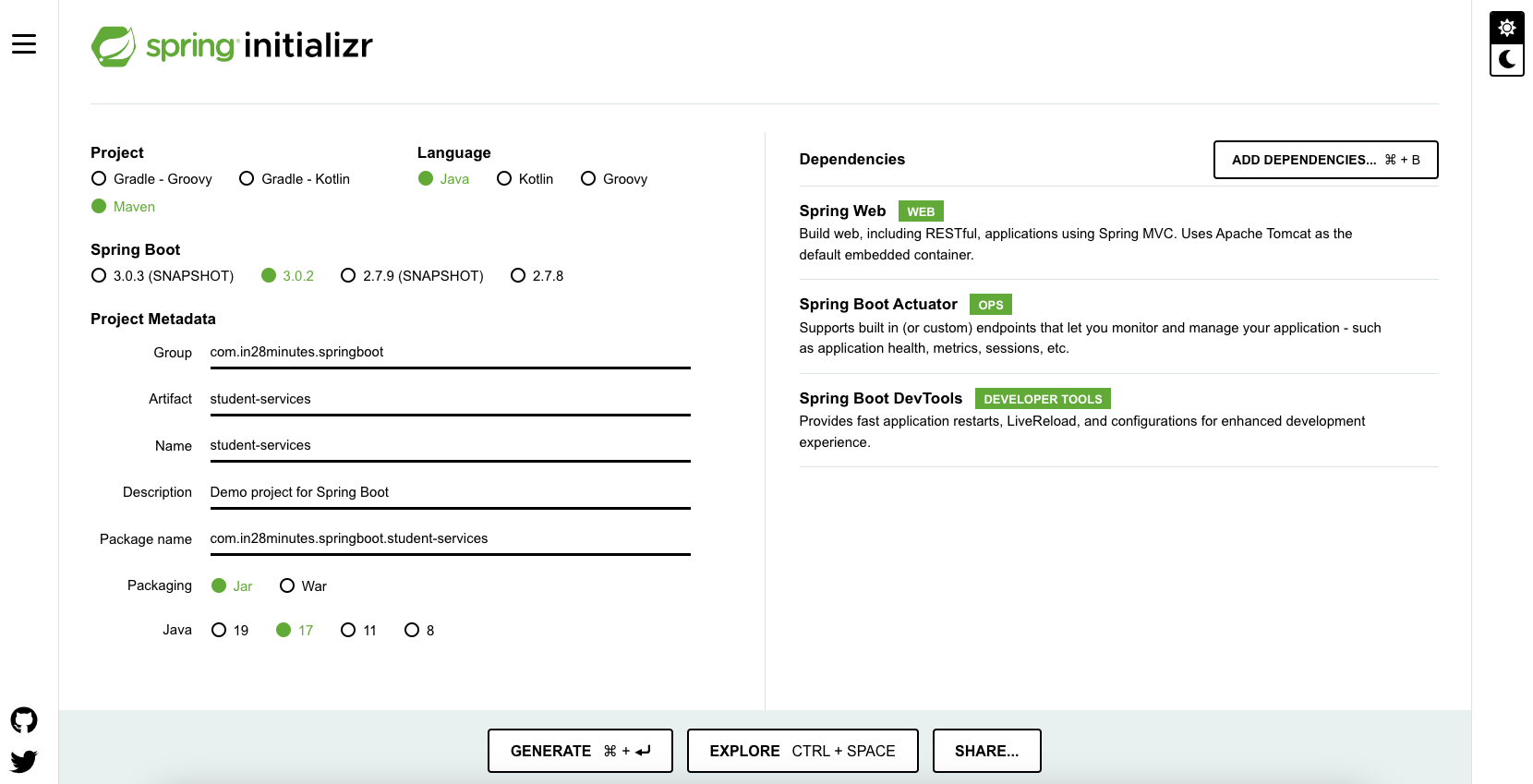
Spring Boot Starter Projects
This guide will help you understand how Spring Boot Starter Projects enable the key goal of Spring Boot — a quick start to developing production-ready applications.
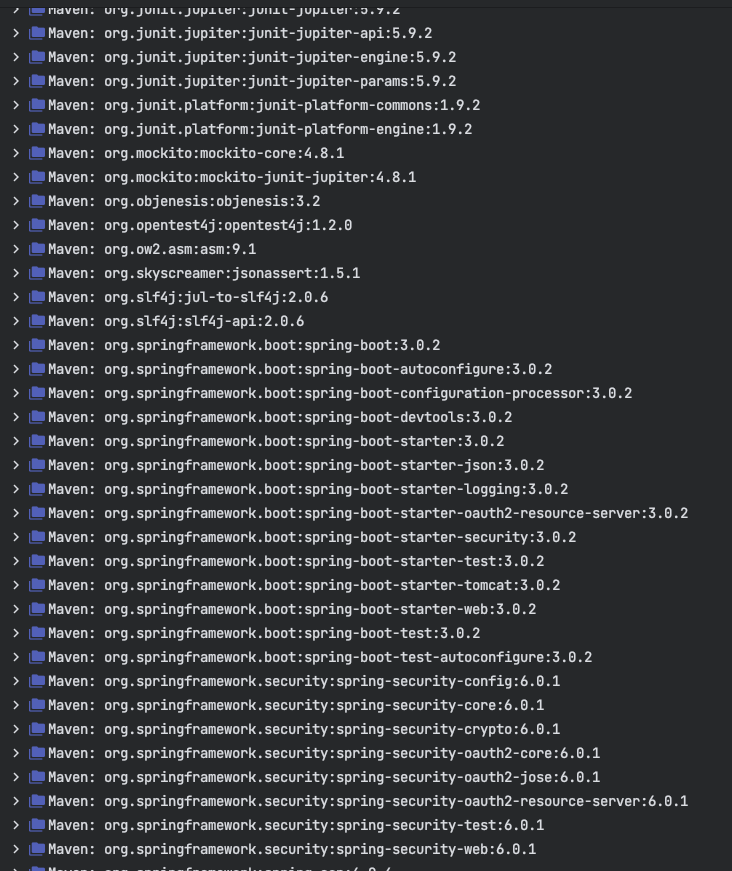
You will learn
- What features are provided by Spring Boot Starter Projects?
- Example of a Starter Project
- Introduction to Spring Boot Starter Web
- Overview of different Starter Projects provided by Spring Boot
Tools you will need
- Maven 3.0+ as your build tool
- Your favorite IDE (Eclipse or IntelliJ IDEA recommended)
- JDK 17+
Why do we need Spring Boot Starter Projects?
To understand the value of starter projects, let’s first imagine a project without them.
What if we do not have starter projects?
Suppose we want to build a Spring MVC web application.
- First, we need to decide which frameworks to use.
- Then, we need to figure out compatible versions of those frameworks.
- Finally, we have to manage linking and configuration manually.
Some of the dependencies we typically use in a Spring MVC project are:
- Spring MVC – Core web framework
- Jackson Databind – For JSON data binding
- Hibernate Validator – For server-side validation using Java Validation API
- Log4j – For logging
👉 The challenge: We must carefully select versions that are compatible with each other, which adds complexity and slows down development.
<dependency>
<groupId>org.springframework</groupId>
<artifactId>spring-webmvc</artifactId>
<version>7.0.0-M7</version>
</dependency>
<dependency>
<groupId>com.fasterxml.jackson.core</groupId>
<artifactId>jackson-databind</artifactId>
<version>2.19.2</version>
<scope>compile</scope>
</dependency>
<dependency>
<groupId>org.hibernate.validator</groupId>
<artifactId>hibernate-validator</artifactId>
<version>9.0.1.Final</version>
</dependency>
<dependency>
<groupId>org.apache.logging.log4j</groupId>
<artifactId>log4j-bom</artifactId>
<version>2.25.1</version>
<type>pom</type>
<scope>import</scope>
</dependency>
To get everything working together, we also had to add manual configurations, such as:
- Dispatcher Servlet
- View Resolver
- Error Page
- Web Jars (for serving static content)
- And other supporting settings
👉 As you can see, without starter projects, setting up even a simple Spring MVC application involves a lot of boilerplate configuration.
<bean
class="org.springframework.web.servlet.view.InternalResourceViewResolver">
<property name="prefix">
<value>/WEB-INF/views/</value>
</property>
<property name="suffix">
<value>.jsp</value>
</property>
</bean>
<bean id="messageSource"
class="org.springframework.context.support.ReloadableResourceBundleMessageSource">
<property name="basename" value="classpath:messages" />
<property name="defaultEncoding" value="UTF-8" />
</bean>
<mvc:resources mapping="/webjars/**" location="/webjars/" />
<servlet>
<servlet-name>dispatcher</servlet-name>
<servlet-class>
org.springframework.web.servlet.DispatcherServlet
</servlet-class>
<init-param>
<param-name>contextConfigLocation</param-name>
<param-value>/WEB-INF/todo-servlet.xml</param-value>
</init-param>
<load-on-startup>1</load-on-startup>
</servlet>
<servlet-mapping>
<servlet-name>dispatcher</servlet-name>
<url-pattern>/</url-pattern>
</servlet-mapping>
We would need to do similar setup tasks when using JPA.
- Provide the required JPA and Hibernate jars
- Configure the DataSource
- Configure the EntityManagerFactory
- Configure the TransactionManager
- Add other related settings manually
👉 As with Spring MVC, this becomes time-consuming and error-prone.
<bean id="dataSource" class="com.mchange.v2.c3p0.ComboPooledDataSource"
destroy-method="close">
<property name="driverClass" value="${db.driver}" />
<property name="jdbcUrl" value="${db.url}" />
<property name="user" value="${db.username}" />
<property name="password" value="${db.password}" />
</bean>
<jdbc:initialize-database data-source="dataSource">
<jdbc:script location="classpath:config/schema.sql" />
<jdbc:script location="classpath:config/data.sql" />
</jdbc:initialize-database>
<bean
class="org.springframework.orm.jpa.LocalContainerEntityManagerFactoryBean"
id="entityManagerFactory">
<property name="persistenceUnitName" value="hsql_pu" />
<property name="dataSource" ref="dataSource" />
</bean>
<bean id="transactionManager" class="org.springframework.orm.jpa.JpaTransactionManager">
<property name="entityManagerFactory" ref="entityManagerFactory" />
<property name="dataSource" ref="dataSource" />
</bean>
<tx:annotation-driven transaction-manager="transactionManager"/>
Spring Boot Starter Projects
Here’s how the official Spring Boot documentation defines starters:
Starters are a set of convenient dependency descriptors that you can include in your application.
You get a one-stop shop for all the Spring and related technologies you need, without having to hunt through sample code or copy-paste loads of dependency descriptors.
For example, if you want to get started using Spring and JPA for database access, just include thespring-boot-starter-data-jpadependency in your project, and you are good to go.
Example: Spring Boot Starter Web
If you want to:
- Build a web application
- Or expose RESTful services
👉 spring-boot-starter-web is the starter you should pick.
Let’s create a simple project with Spring Boot Starter Web using Spring Initializr.
Creating REST Services Applications with Spring Initializr
What is Spring Initializr?
Spring Initializr is an invaluable web-based tool designed to bootstrap your Spring Boot projects quickly and efficiently. It eliminates the complexity of manual project setup by providing an intuitive interface for generating production-ready Spring Boot applications.
Key Configuration Options
When creating your REST services project, you can customize several essential parameters:
Project Configuration
- Project Type: Choose your preferred build automation tool
- Maven - XML-based configuration, widely adopted
- Gradle - Groovy/Kotlin DSL, modern build system
- Programming Language: Select the language that fits your team’s expertise
- Java - Industry standard, extensive ecosystem
- Kotlin - Concise syntax, 100% Java interoperability
- Groovy - Dynamic language with Java compatibility
- Spring Boot Version: Pick the appropriate framework version
- Latest stable release (recommended for new projects)
- LTS versions for enterprise applications
- Snapshot versions for bleeding-edge features
This saves a lot of time by generating a ready-to-use project structure.

Steps to Create a Spring Boot Starter Web Project
As shown in the image above, follow these steps:
- Launch Spring Initializr and choose the following options:
- Group:
com.in28minutes.springboot - Artifact:
student-services - Dependencies:
- Web
- Actuator
- DevTools
- Group:
-
Click “Generate Project” to download the project as a
.zipfile. - Import the project into Eclipse (or your preferred IDE).
- In Eclipse, use:
File > Import > Existing Maven Projects
- In Eclipse, use:
- If you want to understand all the files that are part of this generated project, you can check the detailed explanation here (link to explanation or documentation).
Spring Boot Starter Web
Spring Boot Starter Web has two crucial features:
- Compatible Dependencies that are needed to develop web applications
- Auto Configuration to automatically set up common configurations (DispatcherServlet, Jackson, Validation, Embedded Tomcat, etc.)
Dependency for Spring Boot Starter Web
If you are using Maven, add this to your pom.xml:
<dependency>
<groupId>org.springframework.boot</groupId>
<artifactId>spring-boot-starter-web</artifactId>
</dependency>
If you are using Gradle, add this to your build.gradle:
implementation 'org.springframework.boot:spring-boot-starter-web'
Dependencies
Following screenshot shows the different dependencies that are added in to our application

Dependencies can be classified into:
- Spring - core, beans, context, aop
- Web MVC - (Spring MVC)
- Jackson - for JSON Binding
- Validation - Hibernate Validator, Validation API
- Embedded Servlet Container - Tomcat
- Logging - logback, slf4j
All of these requirements would be used by any regular web application. Spring Boot Starter Site already has them. As a developer, I would not have to be concerned about their dependencies or their compatible version
Auto Configuration
Spring Boot Starter Web automatically configures the essentials. To explore the functionality added by Spring Boot Starter Web, run StudentServicesApplication.java as a Java Application and examine the log.
Mapping servlet: 'dispatcherServlet' to [/]
Mapped "{[/error]}" onto public org.springframework.http.ResponseEntity<java.util.Map<java.lang.String, java.lang.Object>> org.springframework.boot.autoconfigure.web.BasicErrorController.error(javax.servlet.http.HttpServletRequest)
Mapped URL path [/webjars/**] onto handler of type [class org.springframework.web.servlet.resource.ResourceHttpRequestHandler]
Spring Boot Starter Web auto-configures
- Dispatcher Servlet
- Error Page
- Web Jars to manage your static dependencies
- Embedded Servlet Container - Tomcat is the default
The image below shows the different things that might be auto configured by Spring Boot Starter Web
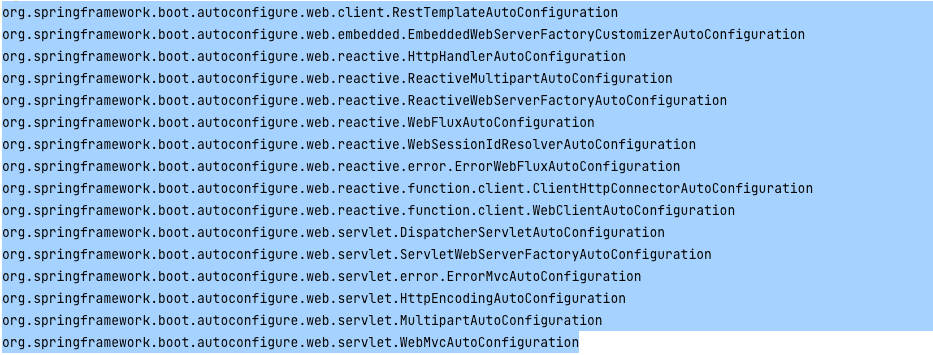
Spring Boot Starter Project Options
As we can see from Spring Boot Starter Web, starter projects allow us to get started quickly with designing various types of applications.
Application Starters
spring-boot-starter-web-services- SOAP Web Servicesspring-boot-starter-web- Web & RESTful applicationsspring-boot-starter-test- Unit testing and Integration Testingspring-boot-starter-jdbc- Traditional JDBCspring-boot-starter-hateoas- Add HATEOAS features to your servicesspring-boot-starter-security- Authentication and Authorization using Spring Securityspring-boot-starter-data-jpa- Spring Data JPA with Hibernatespring-boot-starter-cache- Enabling Spring Framework’s caching supportspring-boot-starter-data-rest- Expose Simple REST Services using Spring Data REST
Technical Starters
spring-boot-starter-actuator- Advanced features like monitoring & tracing out of the boxspring-boot-starter-undertow,spring-boot-starter-jetty,spring-boot-starter-tomcat- Choose your specific Embedded Servlet Containerspring-boot-starter-logging- Logging using Logbackspring-boot-starter-log4j2- Logging using Log4j2
